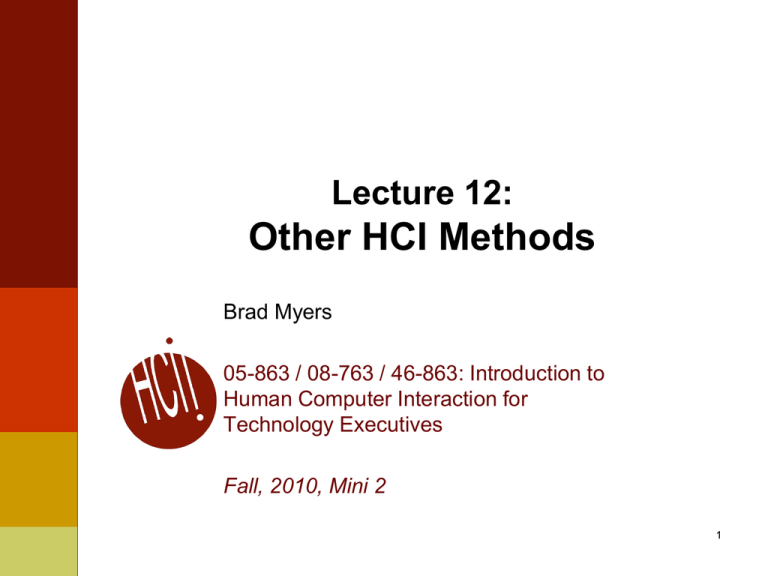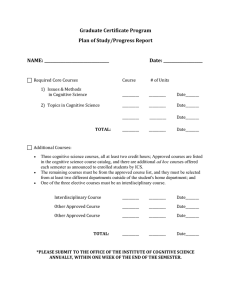Other HCI Methods Lecture 12: Brad Myers
advertisement

Lecture 12: Other HCI Methods Brad Myers 05-863 / 08-763 / 46-863: Introduction to Human Computer Interaction for Technology Executives Fall, 2010, Mini 2 1 Fill Out Class Surveys Now 3 surveys (everyone do all 3): 1. The official CMU course evaluation: http://cmu.onlinecourseevaluations.com or Tepper evaluation (if you are in 46-863) 2. The questionnaire about the textbook -remember, you agreed to fill this out when we gave you the free textbook 3. The class questionnaire: http://www.surveymonkey.com/s/3N279K5 10 minutes (right now!) 2 Final Exam Information Exam Schedule: Thursday, Dec 9, 2010, 1:30pm-4:30pm in Scaife Hall 125 Monday, Dec 13, 2010, 1:30pm-4:30pm in Tepper, Room 146 See full information: http://www.cs.cmu.edu/~bam/uicourse/08763fall10/finalexam.html 3 Some Usability Methods Contextual Inquiry Contextual Analysis (Design) Paper Prototypes Low-Fidelity Prototypes Think-aloud protocols (6) Heuristic Evaluation Affinity diagrams (WAAD) Personas Wizard of Oz Task analysis (5) Questionnaires Cultural Probes Diary studies Card sorting (8) Body storming KLM and GOMS (CogTool) “Speed Dating” Cognitive Walkthrough Cognitive Dimensions Video prototyping Expert interviews Surveys Interaction Relabeling Log analysis Focus groups Improvisation Use cases Scenarios … 4 Other Methods Taught to the HCI Masters students: Others I have used: Cultural Probes & Diary Studies, Card Sorting, "Bodystorming", Keystroke Model & GOMS, "Speed Dating” Cognitive Walkthroughs, Cognitive Dimensions Design methods vs. evaluation methods When are they useful? What kind of information is produced? 5 Design Methods Use along side of CIs to find out more about your users, domains, etc. Many focused more on “feelings” and less on tasks and work Also called generative methods – generate data & designs; also “formative” methods – help form the system Culture, aesthetics, etc. Others get at rare and intermittent occurrences Design methods: Cultural Probes & Diary Studies Card Sorting Bodystorming 6 “Cultural Probes” Bill Gaver, Tony Dunne, & E Pacenti, Design: Cultural Probes, ACM Interactions. vol. 6, no. 1, 1999, pp. 21-29 Goal – learn more about the users’ culture and feelings Give users a variety of recording devices (paper, maps, postcards, disposable cameras, audio-recorders) that they keep for a while Users are asked to record various aspects of their lives Examples: On postcards: “Please tell us a piece of advice or insight that has been important to you.”; “Tell us about your favorite device.” On a map: “Where would you like to go, but can’t” On a camera: “Please take pictures of: Your home; Something desirable; Something boring; whatever you want to show us” Looking for “Inspiration, not Information” Beliefs and desires, aesthetic preferences, and cultural concerns 7 Game-like & fun, but also respectful & interactive Diary Studies A variation on Cultural Probes Give users a diary and ask them to write about relevant events E.g., each time they have a problem with the system E.g., whenever a rare event happens, write about aspects of it Good for rare events that users might not remembers the details of afterwards Must happen when users can take the time to write down 8 Card Sorting Write important concepts on cards Get users to help organize them Hartson-Pyla text says same as Affinity Diagrams, but not necessarily Can find out: What concepts go together? Groupings? What is a reasonable hierarchy? What would be better names for items? For groups? 9 “Bodystorming” Marion Buchenau and Jane Fulton Suri. 2000. "Experience prototyping." In Proceedings of the 3rd conference on Designing interactive systems: processes, practices, methods, and techniques (DIS '00), pp. 424-433. ACM DL PDF Term coined by Interval Research ~ for physically-situated brainstorming Designers pretend to be users, and act out the usage experience Example: buying a ticket at a kiosk In context, with as much fidelity as possible Discover constraints of the context Play different roles in a collaborative situation Now with gloves on, collaborating with another, etc. Example: radio for use in shower, close eyes 10 Evaluation Methods Use along side or instead of user testing & heuristic analyses Also called “summative” methods Get at different kinds of information To assess or compare the level of usability that has been achieved by the design Maximum expert performance How much learning is required? What concepts are needed? Evaluation Methods: Human Performance Modeling: KLM & GOMS “Speed Dating” Cognitive Walkthroughs Cognitive Dimensions 11 Human Performance Modeling John, B. E. (2003) "Information processing and skilled behavior." Chapter 4 In J. M. Carroll, (Ed.), Toward a multidisciplinary science of human computer interaction. Morgan Kaufman. pp. 55-101. Local CMU-only copy Goal: Compute measures of human performance without needing to do user tests Use a “model” of how people work, that has been validated to be reasonably accurate, given certain assumptions Works well for low-level, expert tasks “How long will it take to enter this sequence of commands?” Errors (both novice and skilled) Research on higher-level, problem solving tasks Visual search, figure out how to do things, etc. 12 Wouldn’t it be great… Just point Mr. Bubblehead (the Model Human Processor) at a system, automatically generate performance measures, in context, AND see what’s inside its “mind” and “heart”? Better yet, point Mr. Bubblehead at design ideas (systems that haven’t been built yet) Fast, cheap, easy to interpret Quantitative measures to help persuade 13 Time Constants 14 The simplest model: the Keystroke-Level Model (KLM) 15 Card. Moran & Newell, 1980, 1983 (CMN) Pre-defined level of detail: K (keystroke), P (point with mouse), H (home between devices), M (mental operator), R (system response time) Procedure for constructing a sequence of operators that perform a task Heuristics for placing mental operators Input: A suite of benchmark tasks that are important to your design or evaluation A specification of the proposed system Output: A prediction of the time it would take a skilled user to perform the benchmark tasks on the proposed system Accurate to within about 20% of observed performance Appropriate for skilled performance, without problem solving GOMS models Goals, Operators, Methods, and Selection rules (GOMS) Also originally from Card, Moran, and Newell Significant advances by Bonnie John in HCII and others Multiple strategies (“methods”) possible to do an operation (to reach a “goal”) (e.g., delete a character) Each strategy uses a variety of “operators” “Selection rules” to pick which method E.g., use backspace when previous character, use arrow keys when a few characters away, but use mouse when far away Write these in a special language (e.g., ACT-R, SOAR) and system predicts how long tasks will take. 16 CogTool produces predictions 17 CogTool Bonnie John’s tool to help with Cognitive Modeling http://cogtool.hcii.cs.cmu.edu/ Mock-up an interface in a storyboard Use interactive widgets on a blank canvas States & transitions between those states Useful as a prototyping tool Outputs performance predictions 18 CogTool produces predictions through demonstrating tasks on a storyboard 1. Mock-up design in a storyboard 19 3. Predictions appear in a spreadsheet 2. Demonstrate the tasks Speed Dating Invented by CMU PhD students & faculty (including Prof. Zimmerman), and now widely used Scott Davidoff, Min Kyung Lee, Anind K. Dey, and John Zimmerman. 2007. Rapidly exploring application design through speed dating. In Proceedings of the 9th international conference on Ubiquitous computing (UbiComp '07), Springer-Verlag, Berlin, Heidelberg, 429-446. pdf “Low-cost, rapid comparison of design opportunities and situated applications by creating structured, bounded, serial engagements.” Usually used with sketches & storyboards of various designs that users can react to (Thanks to Prof. Zimmerman for some of these slides) “Highly-disposable creations to support user enactments” Users discuss advantages and disadvantages of different designs/approaches Especially for when no existing product to evaluate “Field work in the future” 20 Designer’s hunches Leverage people’s familiarity with their current experiences in order to: infer how they might react to new products uncover desires they cannot expressed because they cannot imagine the future understand social boundaries the challenge is to connect them with their past experience Really Two Methods needs validation user enactments (like bodystorming for users) Example: 22 “Smart Home” scenarios 23 Example: Speed Dating From an M-HCI 2010 report Each sheet has one scenario 24 Cognitive Walkthroughs Clayton Lewis and John Rieman, "4.1. Cognitive Walkthroughs", in Task-Centered User Interface Design; A Practical Introduction (on-line book), 1994. html Cognitive Walkthroughs: Simulates user problem solving process For addressing ease of exploration Requires specific tasks Expert analysis Determine what knowledge the user would have to have to take each step of the task Ask questions at each step 1. Will users be trying to produce whatever effect the action has? 2. Will users see the control (button, menu, switch, etc.) for the action? 3. Once users find the control, will they recognize that it produces the effect they want? 4. After the action is taken, will users understand the feedback they 25 get, so they can go on to the next action with confidence? Cognitive Dimensions T. R. G. Green and M. Petre. Usability analysis of visual programming environments: A ‘cognitive dimensions’ framework. Journal of Visual Languages and Computing, 7:131—174, 1996. pdf See also: http://www.cl.cam.ac.uk/~afb21/CognitiveDimensions/ 14 heuristics for evaluating usability of programming systems 1. 2. 3. 4. 5. 6. 7. 8. 9. 10. 11. 12. 13. 14. Abstraction gradient Closeness of mapping Consistency Diffuseness / terseness Error-proneness Hard mental operations Hidden dependencies Juxtaposability Premature commitment Progressive evaluation Role-expressiveness Secondary notation and escape from formalism Viscosity Visibility 26



